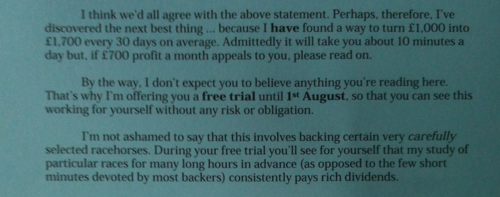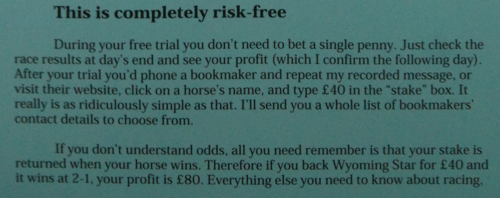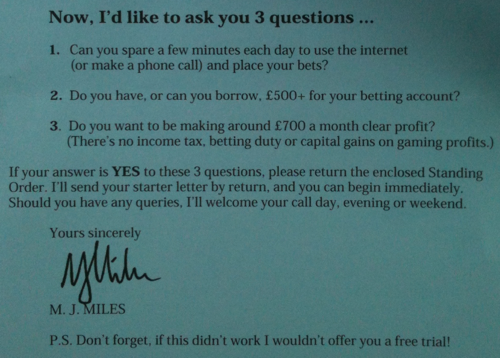Yesterday I received a direct mail package. I don’t know how the mailer got my address because the offer is to buy horse-racing tips and I can’t remember the last time I visited a track.
Because I’m not the target market, my instinct was to bin the mailer. I’ve written previous copywriting case studies on direct mail packages and thought this would be an interesting one for the collection.
Let’s see how the writer is using different techniques to try and encourage the reader to read the mailing in full and take up the offer.
The Headline
 This style of headline is intended to arouse our curiosity, and imply that a common belief of ours is false. (For examples of these headline styles and other quick headline types you can swipe, click here.)
This style of headline is intended to arouse our curiosity, and imply that a common belief of ours is false. (For examples of these headline styles and other quick headline types you can swipe, click here.)
The reader is supposed to assume: “Why is the writer telling me this. Have they found something that disproves this?”
The risk with this particular headline is that the reader simply agrees with the statement and decides there’s no need to read further. The headline also doesn’t actively tell the reader to find out more about the subject, and telling your reader what to do next can be very powerful.
The Opening
 Let’s take the first few paragraphs. In a sales letter this is where you want to make a promise to your audience, and encourage them to read more about your offer. In this case, the writer uses the following copywriting techniques:
Let’s take the first few paragraphs. In a sales letter this is where you want to make a promise to your audience, and encourage them to read more about your offer. In this case, the writer uses the following copywriting techniques:
Offering his version of proof to contradict the headline:
- I have found a way to turn £1,000 into £1,700 every 30 days on average
Providing a shortcut:
- Admittedly it will take you about 10 minutes a day
And making an attractive promise:
- If £700 a month appeals to you, please read on.
Making it risk-free:
- I don’t expect you to believe anything you’re reading here. That’s why I’m offering you a free trial until 1st August so you can see this working for yourself without any risk or obligation.
He also reveals HOW this is going to happen. In my opinion it’s provided too early in the sales letter and I did laugh when I read how I was going to make my fortune (which is a shame):
- I’m not ashamed to say that this involves backing certain very carefully selected racehorses
Then we have another promise:
- During your free trial you’ll see for yourself that my study… consistently pays rich dividends
Trying to Build Credibility
 Next, the writer attempts to build credibility by answering the objection in his reader’s head of “well if he’s so good, why doesn’t he just keep his tips to himself?”
Next, the writer attempts to build credibility by answering the objection in his reader’s head of “well if he’s so good, why doesn’t he just keep his tips to himself?”
The reason he provides, that he does but he wants to capitalise more on his hard work is understandable, but it is lacking in the WIIFM copywriting technique (What’s In It For Me?) The reader is faced with an offer from someone who is basically saying: I’m doing this because I’m rich but want to get richer.” But it is believable and might just work for his target market.
The Details of the Deal
 Here the writer starts explaining what is expected from the reader. This is much too soon. Already he’s talking about needing a £1,000 investment, and betting £40 at a time. We’re only halfway through the first page. At this stage I don’t know if I’m paying him £1,000 to bet with (I’m not) and so this could be a big turn-off to potential customers.
Here the writer starts explaining what is expected from the reader. This is much too soon. Already he’s talking about needing a £1,000 investment, and betting £40 at a time. We’re only halfway through the first page. At this stage I don’t know if I’m paying him £1,000 to bet with (I’m not) and so this could be a big turn-off to potential customers.
This is also where we learn a little more about what the offer is – picking up recorded tips from his website. For me, there’s too much that doesn’t make sense.
Risk-Reversal
 After explaining how we’re going to be picking up tips and betting, the writer now tells us we won’t be betting anything in the first month. So we can assume that we will be getting tips for free for a month and we just check to see how they are doing and track whether we would have won or lost had we placed bets.
After explaining how we’re going to be picking up tips and betting, the writer now tells us we won’t be betting anything in the first month. So we can assume that we will be getting tips for free for a month and we just check to see how they are doing and track whether we would have won or lost had we placed bets.
I have to say, this is a compelling offer of a free-trial because if you do this, you get to see the results in advance, and can decide from there the value of the tips you’ll be receiving.
But because this is introduced quite quickly, I’m assuming that there must be a catch. There isn’t enough explained about the process of how this works, or who this person is and why I should trust their tips.
Even though this is free, I’m not convinced of the quality.
The Offer
 Now our writer tells us what to do. We need to set up a standing order. There is an enclosed slip to set up a standing order for £85. The standing order slip and the stamped envelope are a good idea to make it easy for the reader to take up the call to action. However, the sales letter doesn’t mention the price, and it doesn’t mention what I get for that £85.
Now our writer tells us what to do. We need to set up a standing order. There is an enclosed slip to set up a standing order for £85. The standing order slip and the stamped envelope are a good idea to make it easy for the reader to take up the call to action. However, the sales letter doesn’t mention the price, and it doesn’t mention what I get for that £85.
I’m pretty sure I’m paying £85 to get monthly racing tips, but that is never actually stated.
There is also some mention of a starter letter. As a potential customer, it would be good to find out more about these things.
When making an offer, make it clear what your customer will be receiving, explain what will happen after they pay or register or sign up. Stripping away that mystery is a key part of building trust in your prospect.
Final Details
 This paragraph confuses me. It gives me more details about how it will work, but it doesn’t flow. This should be included in a meatier section of “how this works.”
This paragraph confuses me. It gives me more details about how it will work, but it doesn’t flow. This should be included in a meatier section of “how this works.”
However, what the writer is doing is explaining how the process works, but for me, it’s too brief and I’m not sure I fully understand the reason behind using £40.
The Call to Action
 Here we have the call to action.
Here we have the call to action.
The writer uses numbers and questions to catch the reader’s eye because it breaks the content up and makes it easy to read if you were scanning through the content quickly.
What I like about the questions is that it is qualifying the audience: do you have the time? Do you have the money? Would you like to make more money?
They’re simple and they may find someone who answers a resounding yes to all 3 questions. This is to reinforce the desire for the offer. After engaging the reader with the questions, the writer reinforces the call to action.
Summary
I was bemused by this letter. I’m definitely not the target market and the offer doesn’t appeal to me, but I do like picking up direct mail examples to study how others are using copywriting in their business.
My biggest suggestion for tweaks is to lengthen the letter. As a prospect I would want to see:
- A clearer explanation of the offer – what do I get for my money?
- More credibility about the system – customer testimonials and stories and previous results
- More details about the author. Who is he? What’s his story? What does he look like?
Funnily enough, the writer does have a website with more details about the science behind the system. He could have used content from this site to explain in his letter why his system works.
For the full letter, click on the images below:
Can you spot any other copywriting techniques? Are you sold on the system or what would you like to see to make this more compelling? Let me know in the comments below.



I love how you break down each paragraph. You explained what you liked as well as what you didn’t. Very unbiased of you.
Thanks for the great tips. It’s good to see a critical eye such as yours views this piece.
What do you think of the design of the piece?
Thanks Karl,
I have to say the design (or lack of it) caught my eye because it’s so different to what we normally get in the mail. We’re used to flashy design, bright colours and glossy paper. Unfortunately, that all says to me “advertising” while this looked a little more underground which did pull me in.